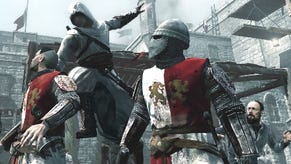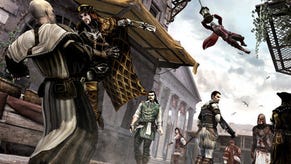Assassin's Creed Revelations Multiplayer
A stab in the dark.
"It was a struggle". That's Damien Kieken, the multiplayer game director for Assassin's Creed, on the prospect of incorporating competitive game modes into a series designed around single player stealth, freedom of movement and one hit kills.
The announcement of multiplayer in Assassin's Creed Brotherhood certainly raised skeptical eyebrows, but the end result won many over with its shrewd understanding of how best to transfer the series' strengths to an online arena. Even so, Damien admits that the multiplayer aspect was "quite complex and hard to get into".
"We saw that when players get it, it was OK, but when you begin you have a lot of things to learn", he accepts. "That's why we're bringing in the Deathmatch mode."
Deathmatch is just one of the new features being added to the multiplayer for Revelations, but it's key to understanding how Ubisoft's Annecy studio, nestled at the foot of the Alps on the Franco-Swiss border, is refining the experience to please as many players as possible. Deathmatch, Damien says, is their way of delivering "the same experience as Wanted, which everyone loved, but in a simpler way, with less rules, less things to learn."
It's also the first mode we get to try as we settle in front of our demo stations, and the difference is immediately obvious. I admired Brotherhood's Wanted mode for its fresh approach to online action, but struggled to make peace with its pace and ended every match as a human pin cushion. In my first Deathmatch, I place first with almost 9000XP.

In principle, little has changed. You still hunt another player, while someone else hunts you. The predator-prey relationship still works beautifully, blending the thrill of the chase with the paranoia of being stalked. It's the little tweaks that make it easier to get into, and more satisfying to succeed.
Screen furniture has been drastically reduced, losing the compass that pointed you towards your quarry in Wanted, and instead giving each player a unique character skin that you'll need to pick out in a crowd. The target portrait still changes colour to tip you off when you're close, but that's all the help you get. And it works, because suddenly you're relying on your own observational skills, your attention fixed on the gameplay area, rather than constantly flicking your gaze downwards to locate your target.
Those who prefer the old style of play needn't start writing furious comments about 'dumbing down', however, as Wanted returns as a legacy mode. "The main purpose is to keep the complex modes, and maybe more complex stuff for those who love it", Damien explains, "But we also wanted to bring new modes that are more streamlined and more straightforward."

Also new in Revelations will be Artefact Assault, a stealthy spin on the old Capture the Flag mechanic. Normally such an obvious addition would warrant little more than a weary roll of the eyes, but the unique qualities of the Assassin's Creed gameplay make it feel pleasingly fresh.
There are no rounds, for one thing. Just two teams of four, each trying to sneak into enemy territory to grab their flag. The map is divided into two, and once on your opponent's turf your role shifts from hunter to hunted, able to stun pursuers but not kill them, subtly changing the way you approach movement, combat and strategy.
What stands out most is how the emphasis on deception, evasion and misdirection fundamentally alters this most familiar of multiplayer setups. Using a disguise ability, you can stroll into the midst of your foes and snatch the flag like a ghost. You can loiter in crowds and pick your moment to strike. Teams can rush the flag from one side, while someone else slips in from the shadows and spirits the prize away over the rooftops.









